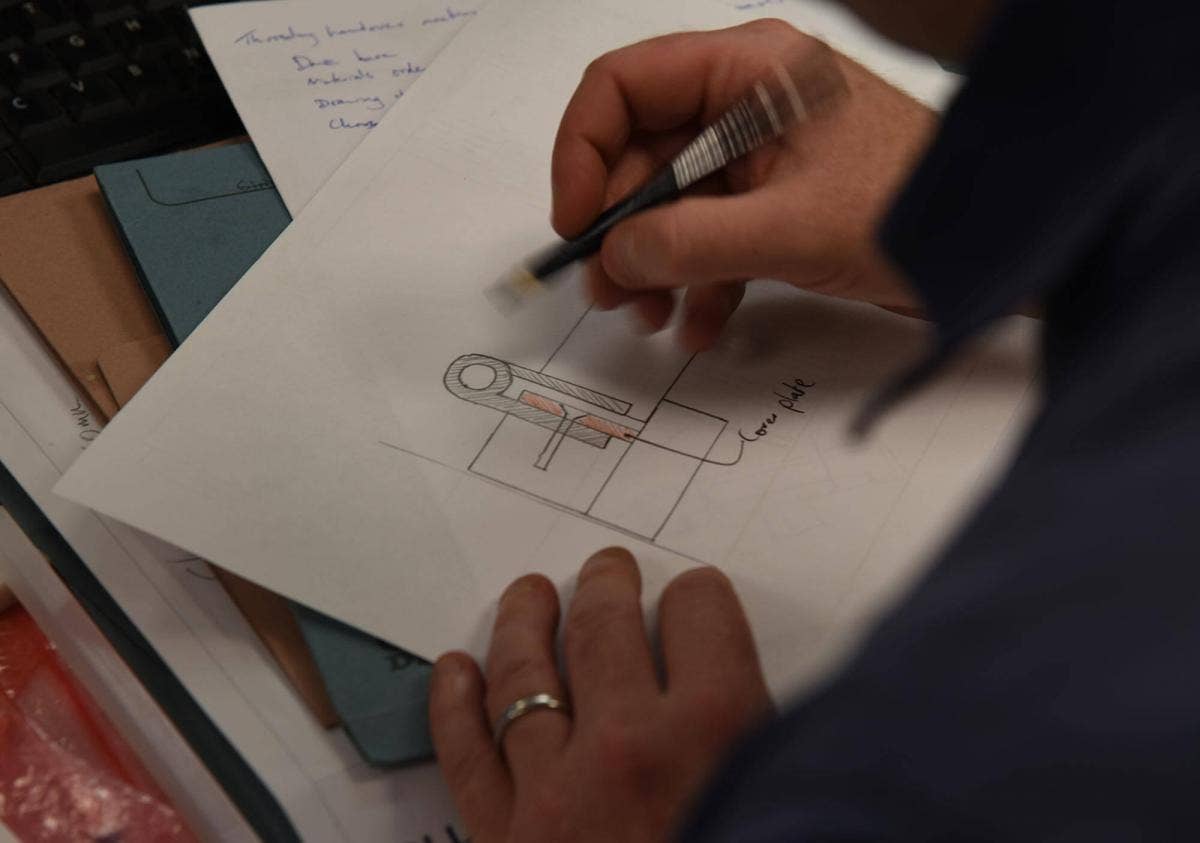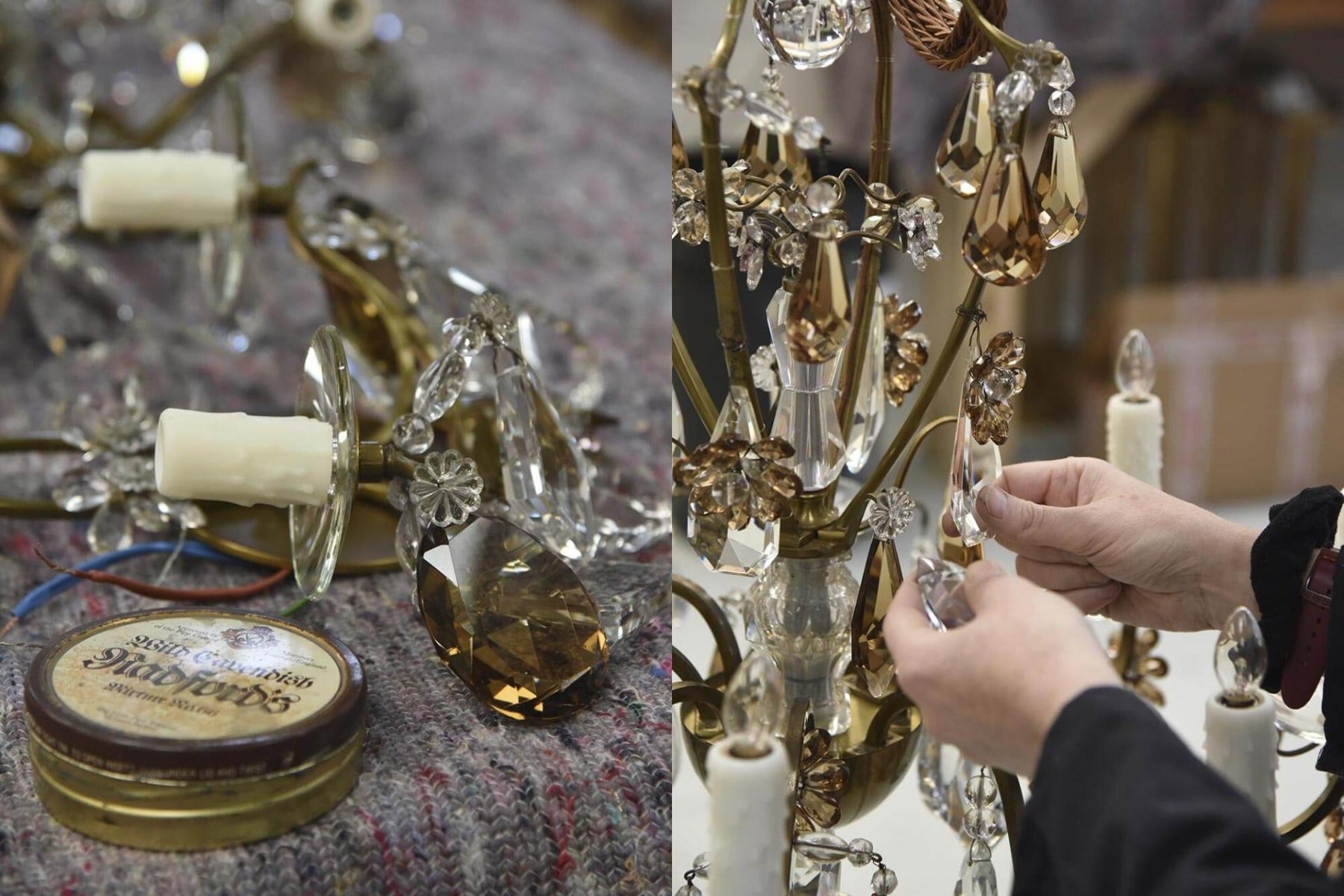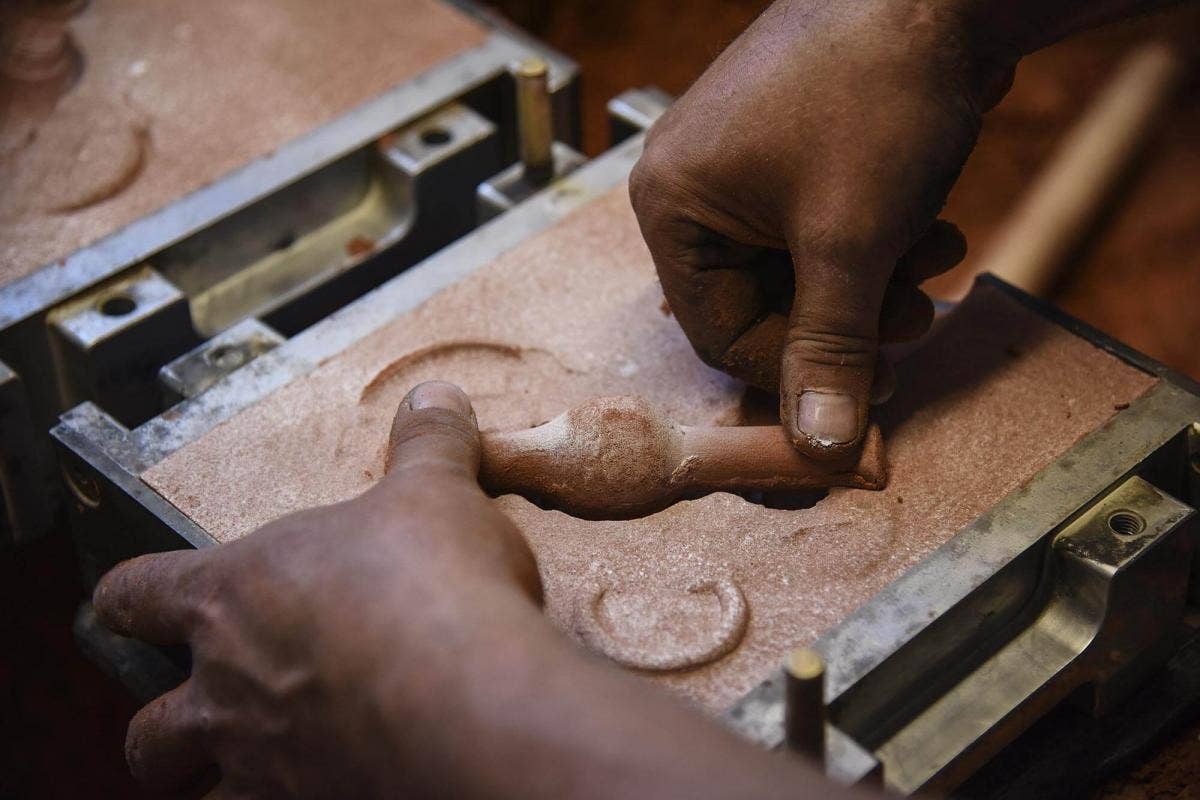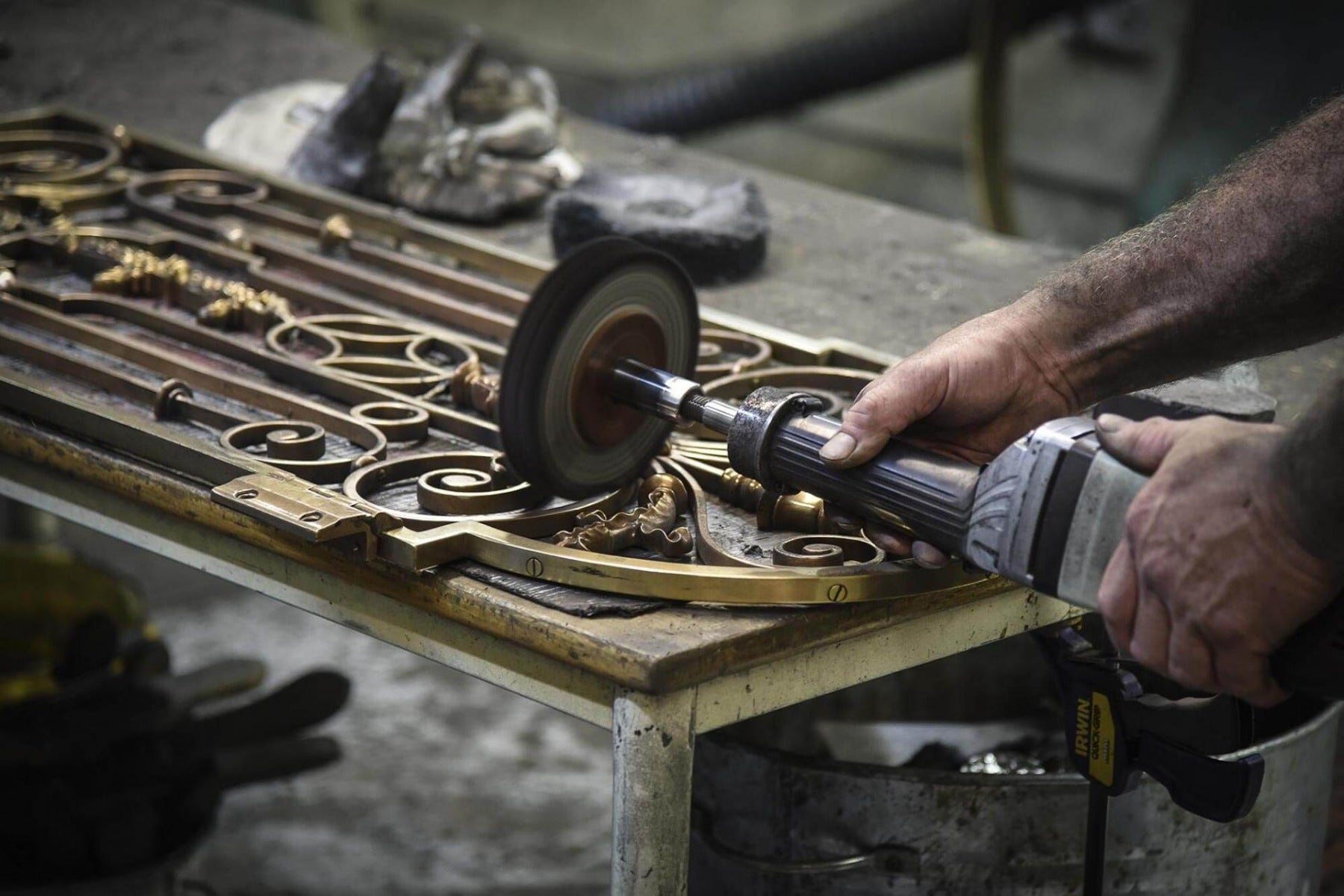Since 1977, the Collier Webb Foundry and Workshop have passionately honed the art of crafting brass castings. Combining traditional methods like lost wax and sand casting with modern techniques, we've meticulously curated a distinctive collection of lighting, furniture, and hardware. Each piece is purposefully designed to complement and enhance the visions of interior designers, architects, and restorers in their diverse projects.
Since 1977, the Collier Webb Foundry and Workshop have passionately honed the art of crafting brass castings.
Combining traditional methods like lost wax and sand casting with modern techniques, we've meticulously curated a distinctive collection of lighting, furniture, and hardware. Each piece is purposefully designed to complement and enhance the visions of interior designers, architects, and restorers in their diverse projects.
Since 1977, the Collier Webb Foundry and Workshop have passionately honed the art of crafting brass castings. Combining traditional methods like lost wax and sand casting with modern techniques, we've meticulously curated a distinctive collection of lighting, furniture, and hardware. Each piece is purposefully designed to complement and enhance the visions of interior designers, architects, and restorers in their diverse projects.

Pattern Making
Our Pattern Making team have all the facilities and skills necessary to carry out this vital stage in the casting process.
In the absence of an original object to be copied, a new solid pattern is needed to make the mould. For lost wax casting the mould is made from flexible silicon and the pattern need not be particularly durable.
An important new asset is our 3D printer which can make solid plastic patterns from 3D drawings. In theory, if it can be drawn on CAD, it can be printed and cast in metal.
Investment
Once the wax trees are ready to go into the oven, the trees are placed in a heat-resistant flask and filled with investment before being placed into a kiln, where it is then melted away.
The wax model inside is then melted and drained away leaving a negative space with a perfect reproduction of the model’s shape and surface detailing.
Requiring more time and skill than other methods, lost wax casting accounts for around 85% of all the brass casting carried out at the Collier Webb Foundry.
Sand Casting
For casting larger items with simpler shapes and less detailing, ‘Sand Casting’ is the preferred method. It is also faster and more economical.
The textured surface of sand-cast metal is not as smooth as that produced from the 'Lost Wax' process but it can be polished or left as a decorative finish in its own right. Castings with relief surface patterns or textures can be aesthetically enhanced by polishing the surface highlights and leaving the background natural.
The sand casting process requires a solid pattern for copying, a sand mould, metal ingots and a furnace. The pattern is used to form cavities in the compacted sand of a two-part mould into which molten metal is poured. When cool, the sand mould is separated along the parting line dividing the two halves of the mould and the solidified casting is removed for cleaning and polishing.
Polishing
Making things bright and shiny is just one tool in the well-equipped armoury of our polishing team and for many of our finishes, a perfectly smooth and reflective surface is essential. But many contemporary finishes such as satin, hammered and hairline require a combination of more subtle techniques and our team thrive on these challenges.
Work in the polishing room can be dirty, hard and physically demanding, particularly when tackling large pieces. The pressure is constant, trying to safely manipulate unwieldy castings into an optimum position on the wheel, is a skill in itself.
A different approach is necessary with smaller decorative pieces, with extra special care being taken to polish beautifully without loss of detail.
Wiring
When a luminaire is not switched on, its aesthetics will never be fully appreciated, no matter how pleasing they may be.
In the design and manufacture of our lighting products, we take the illumination element of the process very seriously. With new and improved technologies, this process is continually evolving and our Wiring team are always ahead of the curve.
A simple flick of the switch may produce an instant transformation but behind the scenes there has been much work, routing wires, secreting drivers, soldering and making connections, matching to specific specifications and testing.
As well as wiring our own and clients’ bespoke products, we also welcome restoration projects which may require re-wiring or electrification, or newly imported luminaires which may not conform to current safety regulations.

Dispatch
When the job is finished, our work is not yet done.
No matter how proud we are of our workmanship, it counts for little unless we can guarantee the safe arrival of our products.
Our experienced packers can securely export to any destination around the world using our partner carriers or clients’ preferred shippers.
Restoration
Our team of experienced CAD designers and project managers have a long experience of working closely with leading designers and private individuals, turning their bespoke design projects into reality.
Working from inspiration images, concepts and sketches, the Collier Webb design team are able to produce 3D renders for client approval and production drawings for manufacturing.
From inception to installation, the team attend meetings and site visits as required to ensure that specifications and scheduling needs are met.
Visits to the Foundry by appointment are always welcome.
Lost Wax
Wax Moulding
To create the highest quality metal castings, the technique known as ‘Lost Wax’ is widely acknowledged as the best process. Indeed, for rendering elaborate shapes and fine detailing, for us it is essential.
A hot wax injector is used during the lost wax process to inject wax into the silicone moulds. The wax fills the mould creating a hollow pattern. This pattern is then fixed onto a wax ‘tree’
Pouring
Once the investment flask is taken out of the kiln, it is allowed to cool. When cooled, it is taken to the Foundry, where the negative space is filled with molten brass which forms the shape of the product.
This is then left to cool, before the investment is blasted off with water, leaving the raw, brass object.

Assembly & Workshop
Assembly can sound like it’s the easy bit of production. Our workshop team are more than mere assemblers though. They are machinists, fabricators, solderers, welders, folders, cutters, grinders, drillers and can boast a mass of other talents.
When castings, raw materials and a set of drawings arrive on their benches, it is this team who use their craft to turn a vision in to reality. Often they are involved at the design stage because their experience is invaluable in making sure every part of the production process results in a finished product that exceeds expectation.
To ensure we can pass their skills on to future generations, we actively recruit young apprentices who are given the opportunity to work in every department to find their métier.

Finishing & Colouring
At Collier Webb, we understand that finish and colour are a major part of a piece’s aesthetic. We have a range of standard finishes selected from our experience of client preferences over the years. And with tastes and trends constantly on the move, our selection is always evolving.
For additional choice, we have the flexibility to offer a bespoke service whereby we will match to client samples.
Our in-house colourers can electro-plate copper, nickel, silver and 24-carat gold. Our patinators skilfully apply heat, chemicals and waxes to produce a variety of antique finishes, from smoky silvers to rich and deep bronzes.
CNC & Fabrication
Our CNC and fabrication workshop features state of the art machinery for 4-axis milling, turning, folding, welding, punching and stamping. Here, our experienced team take the designers’ drawings and turn them in to solid reality.
For our products and clients’ projects, the CNC machinists create all the required component profiles with amazing precision, using brass, bronze, copper, aluminium and steel.
The fabricators have the skills and facilities to shape and join metal sheets into parts as diverse as simple back plates or elaborate sixty-four facet lantern frames.
The ability to perform these operations in-house means that we always have total control over quality and production scheduling.


Restoration
Our team of experienced CAD designers and project managers have a long experience of working closely with leading designers and private individuals, turning their bespoke design projects into reality.
Working from inspiration images, concepts and sketches, the Collier Webb design team are able to produce 3D renders for client approval and production drawings for manufacturing.
From inception to installation, the team attend meetings and site visits as required to ensure that specifications and scheduling needs are met.
Visits to the Foundry by appointment are always welcome.
Pattern Making
Our Pattern Making team have all the facilities and skills necessary to carry out this vital stage in the casting process.
In the absence of an original object to be copied, a new solid pattern is needed to make the mould. For lost wax casting the mould is made from flexible silicon and the pattern need not be particularly durable.
An important new asset is our 3D printer which can make solid plastic patterns from 3D drawings. In theory, if it can be drawn on CAD, it can be printed and cast in metal.
Lost Wax
Wax Moulding
To create the highest quality metal castings, the technique known as ‘Lost Wax’ is widely acknowledged as the best process. Indeed, for rendering elaborate shapes and fine detailing, for us it is essential.
A hot wax injector is used during the lost wax process to inject wax into the silicone moulds. The wax fills the mould creating a hollow pattern. This pattern is then fixed onto a wax ‘tree’
Investment
Once the wax trees are ready to go into the oven, the trees are placed in a heat-resistant flask and filled with investment before being placed into a kiln, where it is then melted away.
The wax model inside is then melted and drained away leaving a negative space with a perfect reproduction of the model’s shape and surface detailing.
Requiring more time and skill than other methods, lost wax casting accounts for around 85% of all the brass casting carried out at the Collier Webb Foundry.
Pouring
Once the investment flask is taken out of the kiln, it is allowed to cool. When cooled, it is taken to the Foundry, where the negative space is filled with molten brass which forms the shape of the product.
This is then left to cool, before the investment is blasted off with water, leaving the raw, brass object.

Sand Casting
For casting larger items with simpler shapes and less detailing, ‘Sand Casting’ is the preferred method. It is also faster and more economical.
The textured surface of sand cast metal is not as smooth as that produced from the 'Lost Wax' process but it can be polished or left as a decorative finish in its own right. Castings with relief surface patterns or textures can be aesthetically enhanced by polishing the surface highlights and leaving the background natural.
The sand casting process requires a solid pattern for copying, a sand mould, metal ingots and a furnace. The pattern is used to form cavities in the compacted sand of a two-part mould into which molten metal is poured. When cool, the sand mould is separated along the parting line dividing the two halves of the mould and the solidified casting is removed for cleaning and polishing.
Assembly & Workshop
Assembly can sound like it’s the easy bit of production. Our workshop team are more than mere assemblers though. They are machinists, fabricators, solderers, welders, folders, cutters, grinders, drillers and can boast a mass of other talents.
When castings, raw materials and a set of drawings arrive on their benches, it is this team who use their craft to turn a vision in to reality. Often they are involved at the design stage because their experience is invaluable in making sure every part of the production process results in a finished product that exceeds expectation.
To ensure we can pass their skills on to future generations, we actively recruit young apprentices who are given the opportunity to work in every department to find their métier.

Polishing
Making things bright and shiny is just one tool in the well-equipped armoury of our polishing team and for many of our finishes, a perfectly smooth and reflective surface is essential. But many contemporary finishes such as satin, hammered and hairline require a combination of more subtle techniques and our team thrive on these challenges.
Work in the polishing room can be dirty, hard and physically demanding, particularly when tackling large pieces. The pressure is constant, trying to safely manipulate unwieldy castings into an optimum position on the wheel, is a skill in itself.
A different approach is necessary with smaller decorative pieces, with extra special care being taken to polish beautifully without loss of detail.
Finishing & Colouring
At Collier Webb, we understand that finish and colour are a major part of a piece’s aesthetic. We have a range of standard finishes selected from our experience of client preferences over the years. And with tastes and trends constantly on the move, our selection is always evolving.
For additional choice, we have the flexibility to offer a bespoke service whereby we will match to client samples.
Our in-house colourers can electro-plate copper, nickel, silver and 24-carat gold. Our patinators skilfully apply heat, chemicals and waxes to produce a variety of antique finishes, from smoky silvers to rich and deep bronzes.
Wiring
When a luminaire is not switched on, its aesthetics will never be fully appreciated, no matter how pleasing they may be.
In the design and manufacture of our lighting products, we take the illumination element of the process very seriously. With new and improved technologies, this process is continually evolving and our Wiring team are always ahead of the curve.
A simple flick of the switch may produce an instant transformation but behind the scenes there has been much work, routing wires, secreting drivers, soldering and making connections, matching to specific specifications and testing.
As well as wiring our own and clients’ bespoke products, we also welcome restoration projects which may require re-wiring or electrification, or newly imported luminaires which may not conform to current safety regulations.

CNC & Fabrication
Our CNC and fabrication workshop features state of the art machinery for 4-axis milling, turning, folding, welding, punching and stamping. Here, our experienced team take the designers’ drawings and turn them in to solid reality.
For our products and clients’ projects, the CNC machinists create all the required component profiles with amazing precision, using brass, bronze, copper, aluminium and steel.
The fabricators have the skills and facilities to shape and join metal sheets into parts as diverse as simple back plates or elaborate sixty-four facet lantern frames.
The ability to perform these operations in-house means that we always have total control over quality and production scheduling.

Dispatch
When the job is finished, our work is not yet done.
No matter how proud we are of our workmanship, it counts for little unless we can guarantee the safe arrival of our products.
Our experienced packers can securely export to any destination around the world using our partner carriers or clients’ preferred shippers.